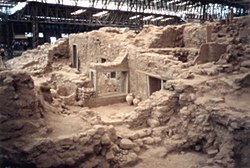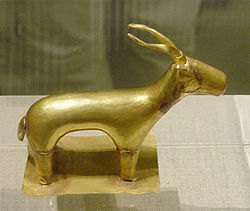From Wikipedia, the free encyclopedia
| Minoan eruption | |
|---|---|

Satellite image of Thera, November 21, 2000
|
|
| Volcano | Thera |
| Date | mid-2nd millenium BCE |
| Type | Plinian |
| Location | Santorini, Greece 36°25′N 25°26′ECoordinates: 36°25′N 25°26′E |
| VEI | 6 or 7 |
| Impact | Devastated the Minoan settlements of Akrotiri and the island of Thera as well as communities and agricultural areas on nearby islands and on the coast of Crete. |
There are no clear ancient records of the eruption; the eruption seems to have inspired certain Greek myths,[6] may have caused turmoil in Egypt,[7][8] and may be alluded to in a Chinese chronicle. Additionally, it has been speculated that the Minoan eruption and the destruction of the city at Akrotiri provided the basis for or otherwise inspired Plato's story of Atlantis.[9][10]
Historical impact
Minoan civilization
Significant Minoan remains have been found above the Late Minoan I era Thera ash layer and tsunami level, and it is unclear whether these effects were enough to trigger the downfall of the Minoan civilization. The Mycenaean conquest of the Minoans occurred in Late Minoan II period, not many years after the eruption, and many archaeologists speculate that the eruption induced a crisis in Minoan civilization, which allowed the Mycenaeans to conquer them easily.[48]
Chinese records
A volcanic winter from an eruption in the late 17th century BCE has been claimed by some researchers to correlate with entries in Chinese records documenting the collapse of the Xia dynasty in China. According to the Bamboo Annals, the collapse of the dynasty and the rise of the Shang dynasty, approximately dated to 1618 BCE, were accompanied by "yellow fog, a dim sun, then three suns, frost in July, famine, and the withering of all five cereals".[7]Effect on Egyptian history
There are no surviving Egyptian records of the eruption, and the absence of such records is sometimes attributed to the general disorder in Egypt around the Second Intermediate Period.Heavy rainstorms which devastated much of Egypt, and were described on the Tempest Stele of Ahmose I, have been attributed to short-term climatic changes caused by the Theran eruption.[7][8][51]
While it has been argued that the damage from this storm may have been caused by an earthquake following the Thera Eruption, it has also been suggested that it was caused during a war with the Hyksos, and the storm reference is merely a metaphor for chaos, upon which the Pharaoh was attempting to impose order.[52]
There is a consensus that Egypt, being far away from areas of significant seismic activity, would not be significantly affected by an earthquake in the Aegean. Furthermore, other documents, such as Hatshepsut's Speos Artemidos, depict similar storms, but are clearly speaking figuratively, not literally. Research indicates that this particular stele is just another reference to the Pharaoh's overcoming the powers of chaos and darkness.[52]




No comments:
Post a Comment